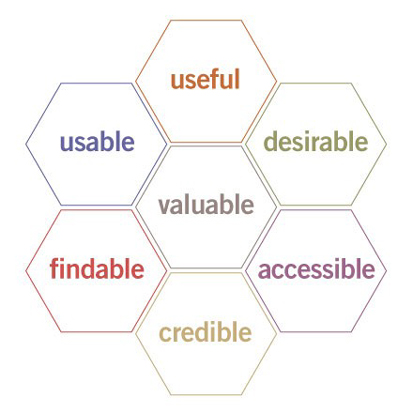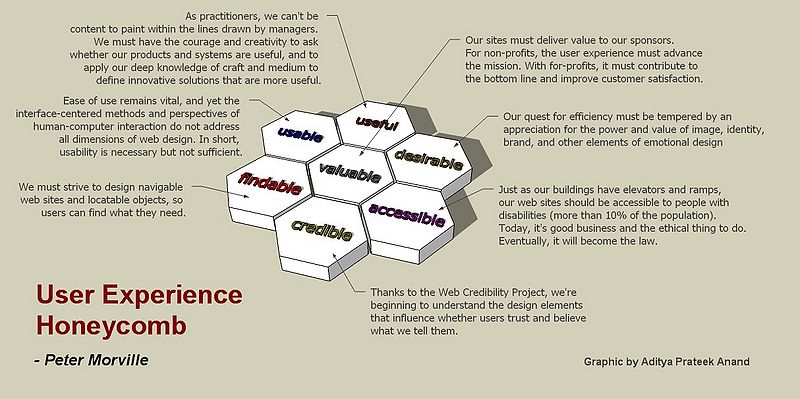User experience and user experience design
<pageby nominor="false" comments="false"/>
Introduction
User experience can be defined as what impact's on the user's perception of something, i.e. it relates to more subjective and emotional aspects. Philipps and Chaparro (2009), based on experimental research, argue that “An attractive homepage entices users to view more of the site and creates feelings of interest and initial satisfaction. If the homepage is unattractive, users do not appear to be interested, nor do they desire more interaction with the site. Designers must develop a homepage that not only attracts user’ attention but also engages them. This research suggests that an attractive site is more likely to pull in users than an unattractive site regardless of how well it is designed from a usability standpoint. An unattractive site, despite high usability, does not attract user interest and maintains low satisfaction.”.
“Experience is an almost overwhelmingly rich concept, with a long history of debate and many attempts to "define" it (Jay, 2004). I primarily focus on experiences as meaningful, personally encountered events (in German: "Erlebnis") and not so much on the knowledge gained through these events (in German: "Erfahrung"). These experiences are memorized stories of use and consumption and distinct from the immediate moment-by-moment experience (e.g., Forlizzi & Battarbee, 2004; Kahneman, 1999). While the immediate moment-by-moment experience is certainly interesting, memorized experience is of more practical relevance. This is simply because most of our waking time, we are feasting on vivid memories of the past (or anticipations) rather than on immediate pleasures.” (Hassenzahl, 2011).
Toward the conclusion in this Encyclopedia of Interaction design article, Hassenzahl then defines experience with a simple three level conceptual model: The Why, the what and the how. “It starts from the Why, tries to clarify the needs and emotions involved in an activity, the meaning, the experience. Only then, it determines functionality that is able to provide the experience (the What) and an appropriate way of putting the functionality to action (the How). Experience Design wants the Why, What and How to chime together, but with the Why, the needs and emotions, setting the tone”.
The goal of user experience design (UXD) can, according to Holger Maassen, be derived from socio-psychological scientist Kurt Lewin's equation of behaviour: B = f (P,E) ( B – Behaviour; f – Function; P – Person; E – Environment ).
See also: Interaction design, user experience and usability (overview article), usability, User interaction and user interface design
Components of user experience design
Depending on whom is asked, either user experience design, interaction design or usability can act as "umbrella" for a whole design process.
Typically, a usability person would consider user experience as part of experience, whereas a user experience design person would state the opposite, i.e. that usability and interaction design are just part of user experience design.
Peter Morville, in User Experience Design (June 2004) create an frequently reproduced honeycomb model that illustrates “the facets of user experience - especially to help clients understand why they must move beyond usability.”

Holger Maassen ( retrieved 16:09, 11 March 2011 (CET)) summarizes theses facets with the following questions:
- Is the application useful for the individual user and his specific task?
- Is the application usable for the individual user and his specific task?
- Is the application desirable for the individual user and his specific task?
- Is the application valuable for the individual user and his specific task?
- Is the application accessible? Available to every individual user, regardless of disability?
- Is the target findable for the individual user and his specific task?
- Is the application credible for the individual user and his specific task?
Aditya Prateek Anand created the following printable mini-poster:

Russ Unger, in a user experience design talk, added the Longevity facet: “Our [websites] must be able to stand the test of time without rebuilding from scratch. Users should expect to see the same styled website for up Longevity to 5 years (or more), with substantial modifications throughout its life.”
Louis Rosenfeld and Jess McMullin (retrieved 16:09, 11 March 2011 (CET)) also position user experience as the integrating view of information architecture, knowledge management, information design, brand management, usability, interaction design, customer relationship management, interface design and content management.
Dan Saffer, defines the Disciplines of User Experience with some nice Venn diagrams, wonder if one could steal these ... (2008, updated 2009).
Usability design vs user experience design
Traditional usability reviews and testing are based on either or extensive usability guideline or on heuristics like Nielsen's or ISO 9241-11 and we introduce in guidelines-based review and heuristic evaluation.
David Green (2006) reports three important criticisms of the ISO 9241-11 standard made by Quesenbery: “(1) It is too focused on well-defined tasks and goals, either ignoring the less tangible elements of user experience or forcing simplistic definitions of tasks (such as reducing an e-commerce site to the simple task "buy things"). (2) The emphasis on efficient and effective as the most important attributes of an interaction make it difficult to talk about how usability applies to products or context where these are less important. Work that looks at pleasure, engagement, or other difficult to measure emotional aspects are often defined as "beyond usability." (3) "Satisfaction" is not a robust enough term to cover the needs in many situations.”
He then argues that “Based on Quesenbery's criticisms, it appears the ISO 9241-11 definition of usability may have been acceptable in a context of enterprise or other work-related applications, but in the consumer world of shopping, information-seeking and online services, the ISO 9241-11 definition is not a broad enough view of human interaction to describe the usability goals of either the users, or the business.”
Links
Introductory articles and tutorials
- ISO 13407 is dead. Long live ISO 9241-210! by David Travis, UserFocus, June 2011.
- User Experience Design by Peter Morville, June 21, 2004. (this is a short often cited/linked introductory piece, good reading).
- UX Design-Planning Not One-man Show, Do we need more UX planning teams?, by Holger Maassen on 2008/05/21 (good reading since this piece also tries to fit the various pieces together, both in terms of relationship and planning)
- Taking the Guesswork Out of Design, A listapart, May 5, 2009, by Daniel Ritzenthaler
- UX Design Defined and UX Design Defined 2 (2008) by Michael Cummings
- Top Seven Definitions of User Experience / UX Design 02/06/08 Michael Cummings
- User Experience Diagrams. A list by by Luke Wroblewski, Feb 2005, updated 2010.
- Nathan Shedroff's papers and presentations “to understand the mechanics of communication on a deeper level”. (Also see Experience design books for commercial offerings)
- How to manage design projects with user experience metrics by David Travis, nov. 2011.
- The Monty Python guide to user experience design, at userfocus.co.uk, by Ritch Macefield, September 3, 2012
- Lean UX Anti-Patterns, slides by Bill Scott on Jun 28, 2012
Web sites
See also the links in the Interaction design, user experience and usability (includes essential introductory resources), usability and User interaction and user interface design articles.
Bibliography
- Forlizzi, Jodi and Battarbee, Katja (2004): Understanding experience in interactive systems. In: of DIS04: Designing Interactive Systems: Processes, Practices, Methods, & Techniques 2004. pp. 261-268. DOI:0.1145/1013115.1013152
- Hassenzahl, Marc (2011). Encyclopedia entry on User Experience and Experience Design. Retrieved 3 March 2011 from Interaction-Design.org: http://www.interaction-design.org/encyclopedia/user_experience_and_experience_design.html
- Jay, Martin (2006): Songs of Experience: Modern American and European Variations on a Universal Theme. University of California Press
- Phillips, C. and Chaparro, B.S. 2009. Visual Appeal vs. Usability: Which One Influences User Perceptions of a Website More? SURL: Software Usability Research Laboratory, Wichita State University. Usability News, 11 (2). HTML/PDF